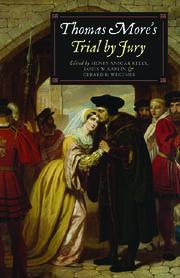Book contents
- Frontmatter
- Contents
- List of Contributors
- Preface
- Abbreviations
- Chronology
- 1 A Procedural Review of Thomas More's Trial
- 2 Natural Law and the Trial of Thomas More
- 3 A Guide to Thomas More's Trial for Modern Lawyers
- 4 Thomas More's Three Prison Letters Reporting on His Interrogations
- 5 Judicial Commentary on Thomas More's Trial
- Appendix 1 Documents
- Appendix 2 Thomas More's Trial: Docudrama
- Bibliography
- Index
5 - Judicial Commentary on Thomas More's Trial
Published online by Cambridge University Press: 05 February 2013
- Frontmatter
- Contents
- List of Contributors
- Preface
- Abbreviations
- Chronology
- 1 A Procedural Review of Thomas More's Trial
- 2 Natural Law and the Trial of Thomas More
- 3 A Guide to Thomas More's Trial for Modern Lawyers
- 4 Thomas More's Three Prison Letters Reporting on His Interrogations
- 5 Judicial Commentary on Thomas More's Trial
- Appendix 1 Documents
- Appendix 2 Thomas More's Trial: Docudrama
- Bibliography
- Index
Summary
The term “maliciously”
What did the word “maliciously” mean in a criminal statute in the sixteenth century?
The noun “malice,” and its adverb, “maliciously,” have long been used as terms of art in legal English (as in “malice aforethought”). According to the OED, these words are derived from Latin and French. The example given for Latin is the word malitia (as in malitia praecogitata”), and for French is the word malice (as in “malice prepensé”). Examples given in the dictionary from English sources show that, in English by the fourteenth century, the word malice had acquired the meaning “ill will,” which it bears to this day. That is a secondary meaning that the word bore in Latin.
In legal English the adverb “maliciously,” and Law Latin maliciose, are used to mean the same as “with malice.” Examples are in the indictment of Thomas More.
In legal English the words “malice” and “malicious” each have two distinct meanings. They are commonly referred to as “malice in law” (or “legal malice”) and “malice in fact” (or “actual malice”).
J. H. Baker discusses murder in the period 1483–1558. He states that what premeditation was required for murder was not precisely defined. None of the cases Baker cites suggests that ill will (or any other motive) was ever required as a constituent of the offense of murder, in addition to intent to do the act in question (actus reus).
- Type
- Chapter
- Information
- Thomas More's Trial by JuryA Procedural and Legal Review with a Collection of Documents, pp. 111 - 136Publisher: Boydell & BrewerPrint publication year: 2011



